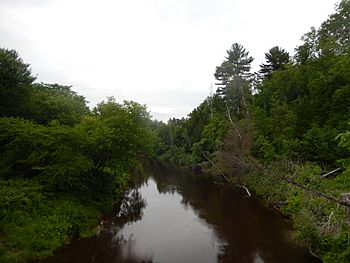Petite rivière du Chêne facts for kids
Quick facts for kids Petite rivière du Chêne |
|
|---|---|

Petite rivière du Chêne from the bridge of the “Le Petit-Deschaillons” cycle path
|
|
| Country | Canada |
| Province | Quebec |
| Region | Centre-du-Québec |
| MRC | L'Érable Regional County Municipality, Bécancour Regional County Municipality |
| Physical characteristics | |
| Main source | Agricultural and forest streams Notre-Dame-de-Lourdes 128 metres (420 ft) 46°20′40″N 71°52′45″W / 46.34438°N 71.87912°W |
| River mouth | St. Lawrence River Deschaillons-sur-Saint-Laurent 5 metres (16 ft) 46°33′26″N 72°02′18″W / 46.55722°N 72.03833°W |
| Length | 35.4 kilometres (22.0 mi) |
| Basin features | |
| River system | St. Lawrence River |
| Tributaries |
|
The Petite rivière du Chêne (in English: Little Oak River) is a tributary of the south shore of the St. Lawrence River, in Quebec, in Canada. This river flows in the municipalities of Notre-Dame-de-Lourdes, Villeroy (MRC de L'Érable Regional County Municipality), Manseau, Fortierville, Parisville and Deschaillons-sur-Saint-Laurent (MRC de Bécancour Regional County Municipality), in the administrative region of Centre-du-Québec.
Geography
The main neighboring watersheds of the Petite rivière du Chêne are:
- North side: St. Lawrence River;
- East side: L'Esperance stream, rivière au Chêne, rivière aux Ormes, Creuse River, Geoffroy stream;
- South side: Bécancour River;
- West side: St. Lawrence River, rivière aux Orignaux, rivière aux Glaises.
The Petite rivière du Chêne has its source in a forest zone, south of a marsh area, south of highway 20, at 3.6 kilometres (2.2 mi) at north of the village of Lourdes, in the municipality of Notre-Dame-de-Lourdes (almost on the edge of Villeroy).
From its head area, the Petite rivière du Chêne flows over 63 kilometres (39 mi) with a drop of 123 metres (404 ft), divided into the following segments:
Upper course of the river (segment of 35.4 kilometres (22.0 mi))
- 6.6 kilometres (4.1 mi) west, in Villeroy, to the municipal limit of Manseau (MRC de Bécancour Regional County Municipality);
- 1.1 kilometres (0.68 mi) west, to highway 20;
- 2.9 kilometres (1.8 mi) west, up to route 218;
- 5.6 kilometres (3.5 mi) towards the north-west, winding until it comes back to cross route 218 south of the village of Manseau;
- 8.3 kilometres (5.2 mi) north-west, winding up to the 10th and 11th rang road;
- 5.3 kilometres (3.3 mi) north, winding up to the road to rang Saint-Agathe;
- 4.2 kilometres (2.6 mi) (or 1.1 kilometres (0.68 mi) in a direct line) north, winding up to the confluence of the Creuse river (coming from the east).
Lower course of the river (segment of 28.2 kilometres (17.5 mi))
From the confluence of the Creuse River, the Petite rivière du Chêne flows over:
- 5.2 kilometres (3.2 mi) (or 3.2 kilometres (2.0 mi) in a direct line) towards the north, winding up to the confluence of the rivière aux Ormes (coming from the east);
- 7.0 kilometres (4.3 mi) (or 2.3 kilometres (1.4 mi) in a direct line) north-west, meandering along route 226;
- 9.3 kilometres (5.8 mi) (or 4.3 kilometres (2.7 mi) in a direct line) north-east, winding up to route 265;
- 6.3 kilometres (3.9 mi) (or 3.8 kilometres (2.4 mi) in a direct line) northeast, winding up to route 132;
- 0.4 kilometres (0.25 mi) eastward to its confluence.
The Petite rivière du Chêne flows over the flats of the south shore of the Estuary of Saint Lawrence, at the limit of Deschaillons and Leclercville. Its confluence is located at Pointe Des Robert, 3.3 kilometres (2.1 mi) west of the center of the village of Leclercville, at 4.4 kilometres (2.7 mi) north-east of the center of the village of Parisville and 5.6 kilometres (3.5 mi) east of the center of the village of Deschaillons. It is also located at 3.3 kilometres (2.1 mi) west of the confluence of Rivière du Chêne and 18.3 kilometres (11.4 mi) east of the confluence of Rivière aux Orignaux.
Toponymy
In the Abenaki language the "little river" is like its "big neighbor" Rivière du Chêne (wachilmezi) like an oak acorn (wachil).
The toponym Petite rivière du Chêne was formalized on December 5, 1968 at the Commission de toponymie du Québec.


